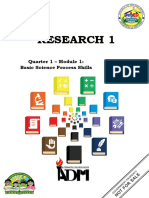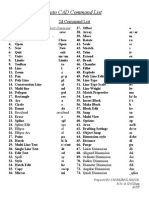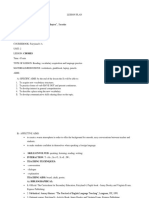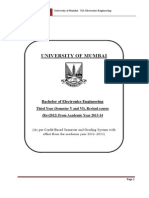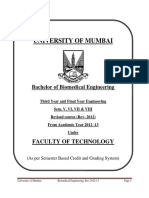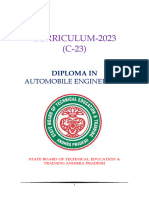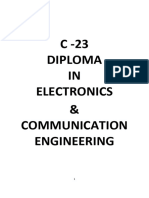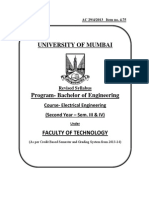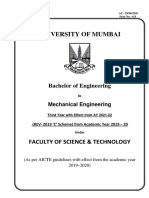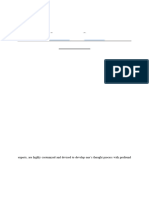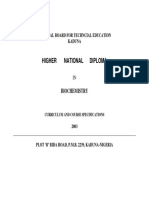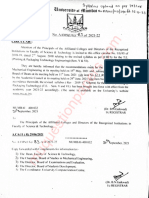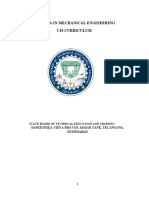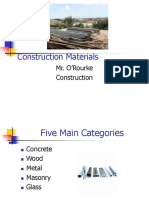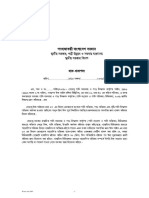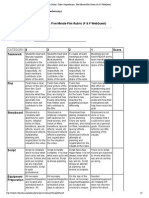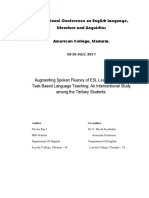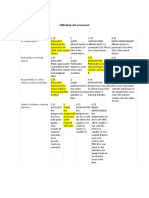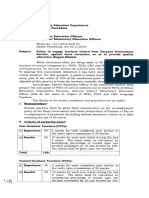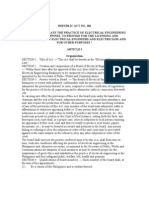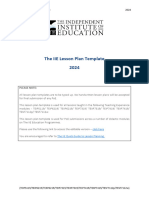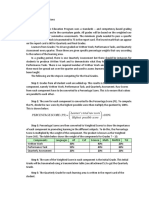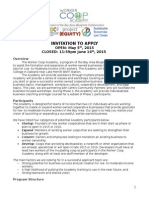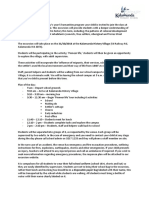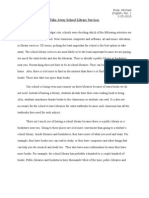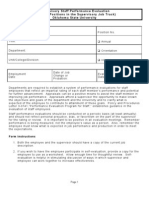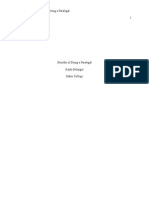4.81 S.E
4.81 S.E
Uploaded by
murad_ceCopyright:
Available Formats
4.81 S.E
4.81 S.E
Uploaded by
murad_ceOriginal Description:
Original Title
Copyright
Available Formats
Share this document
Did you find this document useful?
Is this content inappropriate?
Copyright:
Available Formats
4.81 S.E
4.81 S.E
Uploaded by
murad_ceCopyright:
Available Formats
A
AC29/4/20
013Itemn
no.4.81
U VER
UNIV
RSITY
Y OF
F MU
UMBA
AI
Revised
d Syllab
bus
P
Progr
am-B
Bacheelor off Enggineerring
C
Course
Printiing&P
Packag
gingTe
echnollogy
(SeccondYeaarSem. III&IV)
u
under
FACULTY
Y OF TEC
CHNO
OLOG
GY
( per Credit Basedd Semester and Gradiing System
(As
m from 2013-14)
Deans Preamble
To meet the challenge of ensuring excellence in engineering education, the issue of quality needs to
be addressed, debated and taken forward in a systematic manner. Accreditation is the principal
means of quality assurance in higher education. The major emphasis of accreditation process is to
measure the outcomes of the program that is being accredited. In line with this Faculty of
Technology of University of Mumbai has taken a lead in incorporating philosophy of outcome
based education in the process of curriculum development.
Faculty of Technology, University of Mumbai, in one of its meeting unanimously resolved that,
each Board of Studies shall prepare some Program Educational Objectives (PEOs) and give
freedom to affiliated Institutes to add few (PEOs) and course objectives and course outcomes to be
clearly defined for each course, so that all faculty members in affiliated institutes understand the
depth and approach of course to be taught, which will enhance learners learning process. It was
also resolved that, maximum senior faculty from colleges and experts from industry to be involved
while revising the curriculum. I am happy to state that, each Board of studies has adhered to the
resolutions passed by Faculty of Technology, and developed curriculum accordingly. In addition to
outcome based education, semester based credit and grading system is also introduced to ensure
quality of engineering education.
Semester based Credit and Grading system enables a much-required shift in focus from teachercentric to learner-centric education since the workload estimated is based on the investment of time
in learning and not in teaching. It also focuses on continuous evaluation which will enhance the
quality of education. University of Mumbai has taken a lead in implementing the system through its
affiliated Institutes and Faculty of Technology has devised a transparent credit assignment policy
and adopted ten points scale to grade learners performance. Credit assignment for courses is based
on 15 weeks teaching learning process, however content of courses is to be taught in 12-13 weeks
and remaining 3-2 weeks to be utilized for revision, guest lectures, coverage of content beyond
syllabus etc.
Credit and grading based system was implemented for First Year of Engineering from the academic
year 2012-2013. Subsequently this system will be carried forward for Second Year Engineering in
the academic year 2013-2014, for Third Year and Final Year Engineering in the academic years
2014-2015 and 2015-2016 respectively.
Dr. S. K. Ukarande
Dean, Faculty of Technology,
Member - Management Council, Senate, Academic Council
University of Mumbai, Mumbai
Coordinators Preamble:
As the application of technology spreads its wings, the scope of engineering education spreads
beyond the core disciplines bringing hitherto unheard areas within its ambit. The Printing &
Packaging Technology (PPT) is one such discipline uniquely introduced by the University of
Mumbai in the year 2006 that is now a full-fledged course with immense potential. Accreditation
norms & the industry orientation of the course have been taken into account while framing the
revised structure of the PPT syllabus. Accreditation not only emphasizes ensuring quality but
demands that the courses result in measurable outcomes. The program educational objectives have
been framed taking an all pervasive view and involving all stake holders.
It is a pleasure, as the Coordinator for PPT, to mention here that there was equal participation of
industry and academia in the process of syllabus restructuring and defining the PEOs.
CEOs / MDs / Manager- Sales & Technical Services from major printing and packaging industries
like SMI Coated Product Pvt. Ltd, Gallus India Pvt. Ltd, E.I DuPont India Pvt. Ltd, Ajanta Print
Arts, BASF, UPM Raflatac, Avery Dennison, etc. and experienced Professors from GIPT, UDCT,
PVGS COET also participated in the framing of the PEOs and revision of syllabus. The Program
Educational Objectives are defined as follows1. The graduates / learners of this program should be industry ready workforce with a strong base in
mathematical, scientific and engineering fundamentals.
2. The graduates / learners must acquire high level of technical & research proficiency, analytical
and real-life problem solving skills to generate innovative solutions in packaging and printing
technology or related areas of the program using modern tools effectively.
3. Learners needs to exhibit sustained learning and adapting to a continually changing field through
graduate work, professional development and absolute self study skills so that they can pursue
victorious career in Indian as well as multinational organizations and shine in their postgraduate
studies.
4. Graduates capable to communicate effectively to various stakeholders and practice their
profession with high regard to societal needs, diversity, constraints in the professional workplace
and ethical responsibilities enhancing their leadership and managerial qualities.
In addition to Program Educational Objectives, for each course objectives and expected outcomes
from learners point of view are also included in the curriculum to support the philosophy of
outcome based education.
Further, with a view to bridge the gap between academics and application it was decided at the
behest of the industry to assign the final year project work as a full time one semester apprenticeship
in the packaging and printing industry. The students would be taking up a live project and working
on it in the industry during the eighth semester of the four year course. This would have a two
pronged benefit of the students gaining actual work experience and the industry gaining trained
engineers. The structure and content of the course has been made more relevant to the current needs
of the industry. I am sure this small but significant step would go a long way in furthering the cause
of introducing this discipline.
I believe strongly that small step taken in right direction will definitely help in providing quality
education to the stake holders.
Dr. Alka Mahajan
Coordinator, Printing & Packaging Technology
University of Mumbai, Mumbai
University of Mumbai
Second Year of Engineering - Printing & Packaging Technology
Curriculum for Semester - III
Teaching
Scheme
Hrs/wk
Code
PPC301
PPC302
PPC303
PPC304
PPC305
PPC306
PPL301
Course
L
4
3
4
4
4
19
Applied Mathematics - III
Principles of Packaging Technology
Introduction to Printing Technology
Paper based Packaging Materials
Principles of Graphic Arts & Design
Material Science & Technology
Screen Printing Laboratory
Credits
Assigned
T P L T P
2 - 4 2 - - 3 - - 4 - 3 4 - 1.5
- 4 - - 2
- - 4 - 3 - - 1.5
2 10 19 2 5
C
6
3
4
5.5
2
4
1.5
26
Scheme for Semester - III
Code
Course
Examination Scheme
Theory Marks
Internal
Assessment
End Term Prac Oral Total
Av.
Sem. Work
Test- Test- of
Exam
1
2
Test
1&2
PPC301 Applied
20
20
20
80
25
125
PPC302
20
20
20
80
25
25
150
20
20
20
80
25
25
150
20
20
20
80
25
25
150
25
25
50
20
20
20
80
25
125
25
25
50
100
400
175
75
50
800
PPC303
PPC304
PPC305
PPC306
PPL301
Mathematics - III
Principles of
Packaging Technology
Introduction to
Printing Technology
Paperbased Packaging
Materials
Principles of Graphic
Arts & Design
Material Science &
Technology
Screen Printing
Laboratory
University of Mumbai
Second Year of Engineering - Printing & Packaging Technology
Curriculum for Semester - IV
Code
Course
PPC401
PPC402
PPC403
PPC404
PPC405
Plastics in Packaging
Glass, Metal & Textile based Packaging Materials
Digital Imaging & Colour Management
Offset Printing
Digital Electronics & Microprocessors
Teaching
Scheme
Hrs/wk
Credits Assigned
L
4
3
4
4
4
L
4
3
4
4
4
T
2
-
P
2
3
3
2
T P
- 1
2 - 1.5
- 1.5
- 1
19 2 10 19 2
C
5
5
5.5
5.5
5
26
Scheme for Semester IV
Code
Course
PPC401 Plastics in Packaging
Glass, Metal & Textile
PPC402
based Packaging Materials
Digital Imaging & Colour
PPC403
Management
PPC404 Offset Printing
PPC405 Digital Electronics &
Microprocessors
Examination Scheme
Theory Marks
Internal
Assessment
End Term Prac Oral Total
Av.
Sem. Work
Test- Test- of
Exam
1
2
Test
1&2
20
20
20
80
25
25
25
175
20
20
20
80
25
25
150
20
20
20
80
25
25
150
20
20
20
80
25
25
150
20
20
20
80
25
125
100
400
125
50
75
750
Credits
Course Code
Course Name
PPC301
Applied Mathematics - III
4+2
Objectives:
1. Study Laplace Transform, Fourier Series & Transform.
2. Understand the fundamental aspects of vector calculus & matrices.
3. Study the concept of probability & statistics.
Outcomes: At the end of the course, learners should be able to;
1. Obtain and invert Laplace Transform using standard results and shifting theorem.
2. Determine eigen values & eigen vectors of a matrix and power or exponential of a matrix using
them.
3. Formulate and analyze mathematical & statistical problems followed by drawing clear and
reasonable conclusions.
4. Infer about a particular sample with high degree of reliability.
Sr.
No.
1. Module - 1: Laplace Transform
Definition
of
Laplace
Details
Transform,
Laplace
Hrs
Transform
of
standard
functions, Properties(Linearity, Change of scale) and theorems (First shifting, second
shifting) (without proofs), Laplace Transform of Unit Step
Function, L(t n f (t ) ), L(
12
f (t )
), L( f (u )du), L( f ' (t ))
t
Inverse Laplace Transform: To determine Inverse Laplace Transform by partial
fraction method, Convolution Theorem (without proof). Application of Laplace
Transform to solve differential equations.
2.
Module - 2: Fourier Series & Fourier Transforms
Orthogonal and Orthonormal set of functions, Dririchlets conditions, Fourier series
of periodic functions, Even and Odd functions, Half range Sine and cosine series
14
Fourier Integral theorem (Proof not required) - Fourier Sine and Cosine integral
representations. Fourier Transforms - Fourier Sine and Cosine Transforms
3.
Module - 3: Vector Calculus
Scalar and Vector Point function, Vector differential operator. Directional
06
derivatives, Gradient, Divergence and Curl, Conservative, Irrotational and Solenoidal
fields. Scalar potential.
4.
Module - 4: Matrices
Eigen values and Eigen vectors, properties (without proof), Caley Hamilton Theorem
06
(only statement) and its applications.
5.
Module - 5: Probability & Statistics
Random variables - Probability distributions (Poisson & Normal) moments, moment
generating functions.
Testing of Hypothesis - Large sample tests-Test of Significance difference between
14
sample mean and Opulation mean, means of two samples, Small sample tests
(Students t, F, Chi square)
Texts / References:
1. Higher Engineering Mathematics, B.V Ramana, Tata MacGrawHill
2. Fundamentals of statistics, S.C Gupta Himalaya Publications
3. Matrices, A.R Vasishta Krishana Prakashan media Ltd.
4. Probability statistics and Random process, T.Veerarajan, Tata MacGrawHill
5. A text of engineering mathematics, N.P Bali, M.Goyal Laxmi Publications
Term Work:
Term work shall include tutorials and will carry 25 Marks
Theory Examination:
1. Question paper will comprise of 6 questions, each carrying 20 marks.
2. Total 4 questions need to be solved.
3. Question No.1 will be compulsory and based on entire syllabus.
4. Remaining question will be randomly selected from all the modules.
Internal Assessment:
Compulsory Test-1 will be conducted (on minimum 40% of curriculum) and Test-2 can be class test
(on minimum 70% of curriculum) or assignment on live problems or course project.
Course Code
Course Name
PPC302
Principles of Packaging Technology
Credits
3
Objectives:
1. Study the basic concepts of packaging technology.
2. Understand marketing as an integral tool to packaging.
3. Recognize the importance of product-package interaction & its quality aspects in packaging.
4. Study the overall perspective of the packaging industry.
Outcomes: At the end of the course, learners should be able to;
1. Effectively observe and compare the different package forms.
2. Describe the importance of compatibility studies and their associated parameters.
3. Analyze the various hazards & environmental issues related to Packaging.
4. Predict the application packaging technology as a whole.
Sr.
Details
No.
1. Module - 1: Packaging Introduction:
Hrs
Packaging History, Need & Evolution.
Packaging Functions Contain, Preserve, Protect, Inform, Identify, Sell.
Packaging Hazards Storage, Transportation, Chemical, Climatic, Biological.
09
Packaging Classifications Primary / Secondary / Tertiary, Unit / intermediate /
Bulk, Flexible & Rigid.
2.
Module - 2: Packaging as a Marketing Tool:
Market Considerations Importance of Demography & Psychography, Retail Market
(POP), Equity & Brand Name.
Package Embellishment Graphic Design Elements Significance of Shape, Size,
07
Colour, Font, Texture, Lines, Balance & Unity, Symmetry & Harmony.
Shelf Appeal Studies: Recall Questioning, Focus Group, Eye-Tracking, S-scope
studies
3.
Module - 3: Product-Package Compatibility Studies:
Product Characteristics: Physical (nature, shape, size, texture, Centre of gravity, etc.),
Chemical (Acidic, basic, reactivity etc.), Biological (Effect of micro-organisms) and
09
Effect of moisture, oxygen and other gases.
Package Characteristics: Material (Plastic, paper, wood, etc.), Physical (tensile,
breaking load, burst, molecular/fibre direction, etc.), Chemical (Unreacted chemicals
present, pH, etc.), Biological (sensitivity to micro-organisms), Permeability (Barrier
properties Absorption/Diffusion of moisture and gases).
4.
Module - 4: Introduction to Quality:
Quality Control Need and importance in packaging.
Significance of specifications.
07
Significance of Testing, Introduction to Standards, Conditioning, Sampling.
Examples of testing according to standards.
5.
Module - 5: Packaging Perspectives:
Packaging Costs
Packaging Environmental considerations & waste management.
07
Introduction to Packaging Laws & Regulations.
Packaging Scenario World & India Comparison, Scope & Growth in India.
Texts / References:
1. Soroka W., Fundamentals of Packaging Technology, 3rd Ed, IoPP, 2002.
2. Paine F. A., The Packaging Users Handbook, 1st Ed, Blackie Academic & Professional, 1991.
3. Byett J. et al., Packaging Technology, 2nd Ed, The Institute of Packaging (SA), 2001.
4. Selke, S. E. M., Culter, J. D. and Hernandez, R. J., Plastics Packaging: Properties, processing,
Applications and Regulation, Carl Hanser Verlag, USA, 2004.
5. Joseph F. H, Robert J. K, Hallie F, Handbook of Package Engineering, Third Edition,
Technomic Publishing, 1998.
6. Yam K. L., The Wiley Encyclopedia of Packaging Technology, Third Edition, Wiley, 2009.
Term Work:
Term work shall include assignments and will carry 25 Marks.
Theory Examination:
1. Question paper will comprise of 6 questions, each carrying 20 marks.
2. Total 4 questions need to be solved.
3. Question No.1 will be compulsory and based on entire syllabus.
4. Remaining question will be randomly selected from all the modules.
Internal Assessment:
Compulsory Test-1 will be conducted (on minimum 40% of curriculum) and Test-2 can be class test
(on minimum 70% of curriculum) or assignment on live problems or course project.
Oral Examination:
To gauge the understanding of the subject, an oral examination will be conducted at the end of the
term for 25 marks.
Course Code
Course Name
PPC303
Introduction to Printing Technology
Credits
4
Objectives:
1. Introducing concepts of printing technology along with its evolution & necessity in todays
society.
2. Understand the basic printing processes.
3. Study basic reproduction process, contribution of various elements in designing & typesetting.
4. Study of various materials used in printing processes.
5. Study of various print finishing operations.
Outcomes: At the end of the course, learners should be able to;
1. Distinguish various printing principles like planography, intaglio & relief.
2. Compare the process of image generation on the basis of typography, reprography & layouting.
3. Distinguish the various press configurations of offset, gravure, flexo & letterpress.
4. Recognize various materials used in printing operations and distinguish print finishing operations.
Sr.
Details
No.
1. Module - 1: Basic Principles of Printing Processes
Hrs.
Printing History, Need & Evolution.
Conventional printing processes - Relief printing process, Lithography, Intaglio,
Screen printing and Pad printing. Applications, advantages and their limitations.
10
Digital printing processes - Concept of impact and non-impact, working of electro
photography and ink jet. Applications, advantages and their limitations.
2.
Module -2: Pre - press
Typography- digital font and movable type, type terminology, typeface structure and
parts & type family- definition, style - bold, italic and normal etc. Typesetting and
Measurements - measure & gauge, pica, em, en. Readability & legibility definition,
importance of different spacing.
Reprotechnique- Original and its types, requirements for various printing process.
14
Process cameras- types and basic components. Films types, generation of positive
and negative films, line and half tone film generation, latent image formation and
development. Exposure definition, types, effect of over and under exposure on
films. Need of color separation, Additive and subtractive color theories. Screen
angles and screen resolution concept of juxtaposition, moir pattern.
Layout and imposition- need and significance of imposition technique. DTPIntroduction to DTP, advantages and applications. Proofing need and significance
of proofing, types of proof in brief (soft and hard proof), proofing technique: press
proofers- offset, flexography and gravure. Digital proofers.
3.
Module - 3: Press configurations
Letter press printing technology- flat bed, platen to cylinder, rotary and its
applications. Offset- sheetfed & webfed machines- inline, stack, CIC and perfecting
(Blanket to blanket) mechanism and its applications. Gravure and Flexo- inline, stack
11
and CIC mechanisms (web) and its applications. Screen- flat and rotary printing.
Hybrid press.
4.
Module - 4: Ink and substrate
Classification of ink- paste, liquid (water and solvent base). Basic ingredients of inkspigment resin, vehicle, additive etc.
Printing inks-Letter press, Lithographic, Flexographic, Gravure, Screen printing and
Pad printing. Rheological properties of inks: viscosity, yield value, thixotropy, flow,
08
tack, body length.
Drying methods- Chemical drying, Physical drying. Substrate used in printing- Basic
properties of Paper, Paperboard, Plastic and Foils.
5.
Module - 5: Post press operations
Standard paper sizes-British & ISO. Cutting, slitting, trimming. Binding- folding,
types of folding (parallel and perpendicular folds), gathering, collating, insetting.
09
Binding style-saddle stitching, section binding, perfect binding. Finishing- diecutting, foil stamping, embossing, coating, varnishing and lamination.
Texts / References:
1. Hand book of print and Production Michael Barnard, John Peacock.
2. Printing Materials Science & Technology Vol. 24, J. Anthony Bristow
3. The complete technology book on Printing Inks, Asia Pacific Business Press
4. Typesetting Composition Geoff, Barlow
5. Hand book of Typography Kailas Tahle
6. Printing technology 5th edition, Michael Adams
7. The print and production manual, PIRA
8. Designers Prepress Companion, Jessika Berlin
Term Work:
Term work shall include assignments and will carry 25 Marks.
Theory Examination:
1. Question paper will comprise of 6 questions, each carrying 20 marks.
2. Total 4 questions need to be solved.
3. Question No.1 will be compulsory and based on entire syllabus.
4. Remaining question will be randomly selected from all the modules.
Internal Assessment:
Compulsory Test-1 will be conducted (on minimum 40% of curriculum) and Test-2 can be class test
(on minimum 70% of curriculum) or assignment on live problems or course project.
Oral Examination:
To gauge the understanding of the subject, an oral examination will be conducted at the end of the
term for 25 marks.
Credits
Course Code
Course Name
PPC304
Paperbased Packaging Materials
4+1.5
Course Objectives:
1. Gain the basic knowledge of pulping and paper making process.
2. Study the different types of paper based packages and their manufacturing process.
3. Understand the designing process and estimation of material requirements for major forms
of paper based packaging.
4. Study the major testing standards and properties of paper based packaging materials
as per standards.
Course Outcomes: At the end of the course, learners should be able to;
1. Explain the raw materials and operations involved in pulping and paper making process.
2. Identify and describe the manufacturing process for different types of paper based
packages.
3. Design and estimate material requirements for major forms of paper based packaging.
4. Test and analyze the major properties of paper based packaging materials.
Sr.
No.
1. Module - 1:
Details
Hrs
1.1 Raw Materials and Preparation
Fibrous raw materials Soft and Hard Wood -Wood structure and morphology Non
wood fibres and recycled paper -Non fibrous Additives Sizing Agents, Binders,
Fillers and Additives-Wood harvesting, logging, sorting Debarking, Chipping,
Screening & Storage
13
1.2 Pulping
Types- Mechanical, Chemical and semi-chemical- Mechanical pulping- Stone ground
wood- grinding stone - pressurized grinding-Refiner pulping-refiner plates- Assisted
mechanical pulping thermomechanical, chemimechanical, chemithermomechanicalChemical pulping- Kraft and Sulfite Pulping Chemistry - Liquor Chemicals and
reactions-
Digester
Temperature
and
Pressure
Chemical
recovery
and
environmental effects- Pulp properties Processing of pulp for paper making.
2.
Module - 2:
2.1 Paper Making
13
Preparation of pulp Repulping/dispersion, Beating and Refining, BleachingRecycled paper- Deinking- Washing and Flotation- Fourdrinier Paper MachineDry and Wet end operations- Surface treatments- Sizing, Coating and Super
calendaring.
2.2 Board making
Multiply Board- Cylinder Forming machine- Vat types - Pressure and suction
forming. Pressing, drying and finishing
2.3 Paper properties
Optical properties Colour, brightness, smoothness, gloss, opacity and rub
resistance- Strength properties thickness, grammage, tensile-tear-bursting
strength, stiffness- Grain direction, Wire and Felt sides
3.
Module 3:
3.1 Types of papers
Printing grades-uncoated papers, coated papers, Newsprint, office paperPackaging paper grades, properties and applications - Tissue, Parchment,
greaseproof, glassine, wet strength paper, stretchable paper, coated paper- Boards
used in packaging- Solid bleached/unbleached, folding box board, white lined
13
chip board
3.2 Paper based packaging
Paper bags & SacksManufacturing & Applications- Types of bags- Multiwall
Paper
bags
Composite
containers-
Manufacturing
&
Applications-
convolute/spiral/lap winding Fibre drums- Regenerated Cellulosic films
4.
Module 4
4.1 Cartons and Boxes
Folding Cartons Styles and Applications- Designing and manufacturing - Set up
box applications and manufacturing process- Corrugated Fibre Board(CFB)
structure and materials- Types of flutes and their characteristics- Manufacturing
13
process of CFB- Making of CFB box- Styles of boxes- Properties of CFB- Solid
Fiber board box manufacturing, materials and applications- Moulded pulp board
moulding process, applications
Texts / References:
1. Hand book of Paper and Board, Herbert Holik, Wiley-VCH, 2006
2. Paper and paperboard Packaging Technology, Mark J. Kirwan, Blackwell Publishing, 2005
3. Handbook of Pulp Vol.1, Herbert Sixta, Wiley-VCH, 2005
4. Handbook for pulp and paper technologists, G.A. Smook, Angus Wilde Publications, 2001
Term Work:
Assignments covering the entire syllabus will be given to learners.
During practical sessions learners should understand and perform the practical as per the standard
procedure given by ASTM/IS. Minimum eight practicals should be conducted.
List of experiments:
1. To find Grammage and thickness of paper and board
2. To find Cobb value of paper and board
3. To find Bursting strength and burst factor of paper
4. To find Tearing Strength of paper and grain direction.
5. To find Stiffness of board.
6. To find Puncture resistance of CFB.
7. To Identify flute types in CFB.
8. To find BCT, ECT and RCT of CFB.
9. To find Moisture content of paper.
10. To find pH of Paper.
11. To find out Dimensional Stability of paper.
12. To evaluate Optical Properties of paper-brightness, color and gloss.
13. To make Folding carton for a product.
14. To make paper carry bags.
The distribution of term work marks is as follows:
Assignments:
10 Marks
Practical Journal & Continuous Assessment:
15 Marks
Theory Examination:
1. Question paper will comprise of 6 questions, each carrying 20 marks.
2. Total 4 questions need to be solved.
3. Question No.1 will be compulsory and based on entire syllabus.
4. Remaining question will be randomly selected from all the modules.
Internal Assessment:
Compulsory Test-1 will be conducted (on minimum 40% of curriculum) and Test-2 can be class test
(on minimum 70% of curriculum) or assignment on live problems or course project.
Practical Examination:
To gauge the understanding of the subject, practical examination will be conducted at the end of the
term for 25 marks.
Course Code
Course Name
PPC305
Principles of Graphic Art & Design
Credits
2
Course Objectives:
1. Study the basics of how to create a design.
2. Understand the fundamental principles of design & their types.
3. Study the concept of colour and their effects on design.
4. Understand the method to create visual image and layout.
5. Learn and understand the various softwares used for designing.
Course Outcomes: At the end of the course, learners should be able to;
1. Create a design based on specific requirement.
2. Analyze and demonstrate the use of particular colour & text appropriately in the designs.
3. Generate various design layouts with proper visual impacts.
4. Create a design with different softwares used for designing purpose.
Texts / References:
1. N. N. Sarkar, Art and Print Production, 2nd Impression, Oxford University Press, 2009.
2. Micheal Bernard, The Print and Production Manual, 8th Edition Reprint, Pira International,
UK, 2000.
3. Richard M. Schlemmer, Handbook of advertising art production,2nd Edition,
Prentice-Hall, 1976
4. Alastair Campbell, The Graphics Designer Handbook, MacDonald & Co, 1983
5. David A. Lauer, Stephen Pentak, Design Basics, 6th Edition, Wadsworth, 2005
6. Poppy Evans and Mark A. Thomas, Exploring the Elements of Design,
Delmar Publishers, 2004
7. Albert C. Book, C. Dennis Schick, Fundamentals of Copy and Layout, Crain
Books, 1984
8. Roger Walton, Keith Gillies, Lindsey Heppell, Graphic Design, Ebury Press, 1987
Term Work:
During practical sessions learners should understand and perform the practical as per the standard
procedures. Minimum eight practicals should be conducted.
List of experiments:
1. To draw structure of typeface and different type families.
2. To draw design based on principles of design.
3. To draw colour wheel, primary, subtractive colours chart.
4. To draw different colour schemes.
5. To design Typographical Logo using Software.
6. To design Graphical Logo using Software.
7. To design Designer Logo using Software.
8. To design a visiting card, letter head, envelope of a company.
9. To design an advertisement for magazine for any choice of your product.
10. To design new paper page layout in Adobe InDesign.
11. To design a poster for function using Corel Draw.
12. To design a commercial print products.
The distribution of term work marks is as follows:
Practical Journal & Continuous Assessment:
25 Marks
Practical Examination:
To gauge the understanding of the subject, practical examination will be conducted at the end of the
term for 25 marks.
Course Code
Course Name
PPC306
Material Science & Technology
Credits
4
Objectives:
1. Study the basic concepts of material chemistry and its scientific aspects.
2. Understand structural features of various types of materials along with variation in their
properties.
3. Learn the basics of important characterization and analysis techniques for various materials.
Outcomes: At the end of the course, learners should be able to;
1. Point out effectively various materials and their feasible applications involved in packaging &
printing technology.
2. Explain the materials on the basis of their chemistry.
3. Identify and examine various significant properties required for a specific material for a
particular application.
Sr.
No.
1. Module - 1:
Details
Hrs
1.1. Introduction to Materials Science
Scope of Material Science & Technology - Importance in Packaging & Printing
Technology - Classification of Materials - Concept of Matter and its Chemistry
1.2. Atomic Structure and Chemical Bonding
Structure of the Atom - The Quantum States. The Periodic Table & its trends - Wave
nature of electron and Schrodinger wave equation.
09
Chemical Bonding - Bond energy - Bond type & length - Types of Bonds - Variation
in bonding character and properties - Molecular Structure
2.
Module - 2:
2.1. Crystal Structures
Review of Unit Cells - Crystal Structures - Polymorphism & Allotropy - Miller
Indices of Planes & Directions - Crystallinity & Non-Crystallinity - Review of
09
Braggs Law
2.2. Crystal Imperfections
Point imperfection - Dislocations or line imperfections - Burgers vector - Critical
resolved shear stress - Dislocation theory - Surface & Volume imperfections
2.3. Structure of Glass & Ceramics
Ceramic Crystal Structures -Silicate Structures - Structure of Glass - Graphite, CNT
& Fullerenes - Glass Ceramics
3.
Module - 3:
3.1. Structure of Polymers
Review of Organic Monomers - Classification - Tacticity & Isomerism - Significance
of Molecular Weight & Crystallinity - Defects in Polymers
3.2. Structure of Composites
Composite Constituents - Classification - Composite Reinforcement - Interface
08
Interactions
3.3. Structure of Biological Materials
Basic biological molecules - Structure of Carbohydrates, Proteins, Acids & Fats Basic Properties
4.
Module - 4:
4.1. Mechanical Properties of Materials
Elastic Deformation - Stress Strain Behaviour - Plastic Deformation - Recovery Compressive, Shear & Torsional Deformations - Hardness - Dislocation & Slip Recovery - Recrystallization & Grain Growth - Fatigue - Mechanism of fatigue
failure - Characteristics & Factors of fatigue failure - Creep - Types of creep - Creep
curve
10
4.2. Rheological Properties of Materials
Newtonian & Non-Newtonian Behaviour - Viscosity - Shear Stress vs. Shear Rate
Study
4.3. Thermal Properties of Materials
Heat Capacity - Conduction, Convection & Radiation - Study of Thermal Stresses in
Materials
5.
Module - 5:
5.1. Electrical Properties of Materials
Electrical Conductivity - Band Model of Conductivity - Semiconductors - Valence
10
band model - Dielectric Properties & materials. - Ferroelectricity - Piezoelectricity
5.2. Magnetic Properties of Materials
Basic Concepts - Dimagnetism, Paramagnetism & Ferromagnetism - Hysteresis Superconductivity
5.3. Optical Properties of Materials
Electromagnetic Spectrum - Atomic & Electronic Interactions - Reflection,
Refraction, Absorption & Transmission - Colour & Absorbance - Opacity &
Translucency - Photoluminiscence Electroluminiscence
6.
Module - 6:
6.1. Characterization of Materials
Analysis of Materials - Introduction to Microscopy - SEM, TEM, AFM, XRDIntroduction to Elemental Analysis - EDX, Auger, MS, XPS - FTIR
06
6.2. Advanced Materials
Nanomaterials - Biomaterials & Soft Condensed Matter - Smart Materials
Texts / References:
1. W.D. Callister, Materials Science and Engineering, John Wiley, New York, 1997
2. V. Raghavan Materials Science and Engineering, Addison Wesle, New York, 1989
3. J.F. Schackelford, Introduction to Material Science for Engineers, 2nd ed., McMillan, New
York, 1990
4. B. S. Mitchell, An Introduction to Materials Engineering and Science, Wiley InterScience, 2004
5. B. Vishwanathan, Catalysts and Surfaces: Characterization Techniques, Alpha Science Int.
Ltd., India, 2010
Term Work:
Term work shall include assignments and will carry 25 Marks.
Theory Examination:
1. Question paper will comprise of 6 questions, each carrying 20 marks.
2. Total 4 questions need to be solved.
3. Question No.1 will be compulsory and based on entire syllabus.
4. Remaining question will be randomly selected from all the modules.
Internal Assessment:
Compulsory Test-1 will be conducted (on minimum 40% of curriculum) and Test-2 can be class test
(on minimum 70% of curriculum) or assignment on live problems or course project.
Course Code
Course Name
PPL301
Screen Printing Laboratory
Credits
1.5
Course Objectives:
* Introduce the concept of screen printing techniques.
* Understand the screen printing technology for four color printing.
* Gain knowledge about different applications of screen printing.
Course Outcomes: At the end of the course, learners should be able to;
* Prepare screen printing image carrier by direct, indirect photographic methods.
* Demonstrate the use of different photographic films for mesh preparation according to image.
* Produce different printed samples for various substrates like fabric, glass, acrylic, wood by
selecting suitable inks & coatings for that material.
* Produce & analyze a halftone dot image generated for four color printing and registration of color.
Term Work:
During practical sessions learners should understand and perform the practical as per the standard
procedures. Minimum eight practicals should be conducted.
List of experiments:
1.
Study of screen printing equipments and materials.
2.
Determining optimum exposure for various stencil methods.
3.
Centering the image for various size stocks.
4.
Screen preparation and printing by direct method.
5.
Screen preparation and printing by indirect method.
6.
Screen preparation and printing by direct-indirect method.
7.
Printing two colour image on paper and textile.
8.
Preparation of screen for halftone image.
9.
Screen Printing on textile T-Shirt.
10. Screen Printing on PVC, acrylic sheet.
The distribution of term work marks is as follows:
Practical Journal & Continuous Assessment:
25 Marks
Practical Examination:
To gauge the understanding of the subject, practical examination will be conducted at the end of the
term for 25 marks.
Course Code
Course Name
PPC401
Plastics in Packaging
Credits
4+1
Objectives:
1. Understand the fundamentals of polymer science.
2. Study and appreciate the macro, micro & molecular level interaction in polymers.
3. Learn the factors that affect rheological properties of plastics.
4. Study the different types of plastics and their associated properties.
5. Understand the various testing methods employed on plastic materials.
Outcomes: At the end of the course, learners should be able to:
1. Describe the various polymerization mechanisms and techniques.
2. Differentiate between thermoplastics & thermosets.
3. Effectively communicate the relation between effects of temperature and crystallinity of
polymers.
4. Identify and categorize various plastics by chemical and instrumentation methods.
5. Choose a plastic material for a specific application based on their physical and chemical
properties.
6. Describe the properties that are important from the point of view of plastic processing.
Sr.
Details
No.
1. Module - 1: Polymer Science Introduction:
Hrs
Polymers Definition.
Polymers Classification based on origin, physical properties, molecular structure,
06
etc.
Plastics Definition, History, Plastics industry and overview of manufacture.
2.
Module - 2: Plastics Molecular Level Characteristics:
Bonding in plastics, formation of plastics polymerization reaction.
Polymerization mechanisms (Addition & Condensation).
Types of polymerization (Bulk, Solution, Suspension & Emulsion).
08
Significance and examples of Copolymers.
Thermosets and Thermoplastics Definition and properties.
3.
Module - 3: Plastics Micro Level Characteristics:
08
Amorphous and crystalline plastics.
Degree of Polymerization, Polymer length, Concepts of Molecular Weight &
Molecular Weight Distribution.
Thermal changes Glass Transition Temperature (Tg), Softening/ Melting
Temperature (Tm), Degradation Temperature (Td). Heat Distortion Temperature.
Understanding Melt Flow Index of plastics.
4.
Module - 4: Plastics Macro Level Characteristics:
Mechanical Properties: Understanding Elastic, viscous and viscoelastic behaviours of
solids & liqids. Plastic behaviour: Stress-strain curve. Creep, toughness, impact
strength of plastics.
Chemical & Physical Properties: Environmental resistance and weathering, Chemical
resistivity and solubility, Permeability, electrical Properties, Optical Properties,
Flammability.
10
Additives for plastics: Process of Compounding, Different additives like Antislip,
Antistatics, Colourants, Fillers, Plasticizers, etc. Plastic Masterbatches & their types.
5.
Module - 5: Commodity Plastics in Packaging:
Polyethylene (PE): Types, Properties & Applications.
Polypropylene (PP): Varieties, Properties & Applications.
Polyvinyl Chloride (PVC): Properties, Compounding & Applications.
09
Polystyrene (PS): Types, Properties & Applications.
Copolymerization, Alloying and Blending.
6.
Module - 6: Engineering & Speciality Plastics in Packaging:
Properties & Applications of Engineering Plastics:
Thermoplastics Polyesters (PET & PBT), Polycarbonate (PC), Acrylics (PAN &
PMMA), Polyamide (PA 6 & PA 6,6).
07
Properties & Applications of Speciality Plastics:
Polyvinylidene chloride (PVdC), Ethyl Vinyl Acetate (EVA), Ethyl Vinyl Alcohol
(EVOH), Ionomer, Polychlorotrifluoroethylene (PCTFE)
7.
Module - 7: Thermosets:
Applications of Amino plastics (Urea Formaldehyde & Melamine Formaldehyde),
04
Phenolics, Epoxies, Unsaturated Polyesters, Polyurethane.
Texts / References:
1. Strong A. B., Plastics: Materials and Processing, 3rd Ed, Pearson-Prentice Hall, 2006.
2. Gowariker V. R., Viswanathan N. V., Sreedhar J., Polymer Science, 1st Ed, New Age
International Publishers, 1986.
3. Selke, S. E. M., Culter, J. D., Hernandez, R. J., Plastics Packaging: Properties, processing,
Applications and Regulation, Carl Hanser Verlag, USA, 2004.
4. Margolis J. M., Engineering Plastics Handbook, 1st Ed., McGraw-Hill, 2006.
5. Athalye A. S., Handbook of Packaging Plastics, 1st Ed., Multi Tech Publishing Co., 1999.
6. Yam K. L., The Wiley Encyclopedia of Packaging Technology, 3rd Ed., Wiley, 2009.
Term Work:
Assignments covering the entire syllabus will be given to learners.
During practical sessions learners should understand and perform the practical as per the standard
procedure given by ASTM/IS. Minimum eight practicals should be conducted.
List of experiments:
1.
Identification of Plastics by chemical Method.
2.
Identification of Plastics by instrumentation method (DSC).
3.
Study of thermal changes in plastics by Differential Scanning Calorimeter.
4.
Identification of Plastics/layers of laminate by instrumentation method (FTIR).
5.
Determination of Impact resistance by free falling Dart method.
6.
Determination of tensile strength of plastics films.
7.
Determination of specular gloss of plastic films.
8.
Determination of Coefficient of friction of plastic films.
9.
Study of water vapour transmission rate test for plastic films.
10. Study of oxygen / gas transmission rate test for plastic films.
11. Study of Environmental Stress Crack Resistance of plastic items.
12. Study of Melt Flow Index tester.
The distribution of term work marks is as follows:
Assignments:
10 Marks
Practical Journal & Continuous Assessment:
15 Marks
Theory Examination:
1. Question paper will comprise of 6 questions, each carrying 20 marks.
2. Total 4 questions need to be solved.
3. Question No.1 will be compulsory and based on entire syllabus.
4. Remaining question will be randomly selected from all the modules.
Internal Assessment:
Compulsory Test-1 will be conducted (on minimum 40% of curriculum) and Test-2 can be class test
(on minimum 70% of curriculum) or assignment on live problems or course project.
Practical & Oral Examination:
To gauge the understanding of the subject, practical and oral examination will be conducted at the
end of the term each of 25 marks.
Course Code
Course Name
PPC402
Glass, Metal & Textile based Packaging
Credits
3+2
Objectives:
1. Understand the use and application of primary packaging materials i.e. glass and metal.
2. Study the types of textile materials and their application
3. Learn the basics package forms and the technology to manufacture them for the above listed
materials.
Outcomes: At the end of the course, learners should be able to;
1. Describe & interpret the various manufacturing process for glass bottles, metal cans & tubes and
textile based bags .
2. Explain various design aspects for various types of package forms made up of glass & metal.
3. Summarize the aerosol technology and its wide application in packaging.
4. Discuss various quality control and testing procedures for these package forms.
5. Describe the basics of fabric & textile technology to produce bags of various materials like jute,
hemp etc.
Sr.
No.
1. Module - 1: Glass in Packaging
Details
Hrs
Introduction & History of Glass Materials - Composition - Chemical Structure - Raw
Materials used for manufacturing glass containers - Glass properties - Glass Industry
- Market Overview
13
Glass Manufacturing Process - Container Forming Processes - Study of important
control parameters during the processes - Post forming Treatments or processes
Types of Glass - Types of glass containers - Advantages & Disadvantages Applications
Glass bottle design - Specifications & Quality Control - Defects
2.
Module - 2: Metals in Packaging
Introduction & History of Metals - Overview of Extraction Processes - Important
Metals in Packaging & their properties - Market & Industry Overview
18
Aluminium based: Conversion processes for Sheets - Aluminium Foil, properties &
their applications
Steel based: Stainless & Glavanized Steel - Coated steels like Tinplate, Tinfree Steel,
Polymer coated - Manufacturing Process & Description
Metal Cans: History of Metal Cans - Three piece & Two piece Cans - Draw &
redraw, Draw & iron, Walled iron Cans - Welded & Seamless Cans - Can
Dimensioning - Specifications & Quality Control - Defects
Collapsible Tubes - Manufacturing process - Design of Metal Collapsible Tubes Advantages & Disadvantages of Metal Collapsible tubes
Aerosol Containers - Classification of Aerosols - Design Features - Components Filling Process - Advantages & Disadvantages of Aerosols - Applications
Overview of metal corrosion and anticorrosion techniques
3.
Module - 3: Textile based Packaging
Materials for textile based packaging - Raw materials like Jute, Hemp etc. Terminologies - Sack Manufacturing Process - Jute Bag classification like Hessians,
08
Tarpaulins & Twilled - Finishing Treatments -Standardization of Sizes - Lining & its
Significance - Applications - Comparison with Plastic Bags
Texts / References:
1. K. L. Yam,The Wiley Encyclopedia of Packaging Technology, 3rd ed., Wiley, 2009
2. W. Soroka, Fundametals of Packaging Technology, 4th ed., IoPP, 2009
3. J. F. Hanlon, Handbook of Package Engineering, 3rd ed., CRC Press, 1998
4. F. A. Paine, The Packaging Users Handbook, Springer, 1990
Term Work:
Term work shall include tutorials & assignments and will carry 25 Marks.
During tutorial sessions learners should study the standard testing procedures given by ASTM/IS.
Theory Examination:
1. Question paper will comprise of 6 questions, each carrying 20 marks.
2. Total 4 questions need to be solved.
3. Question No.1 will be compulsory and based on entire syllabus.
4. Remaining question will be randomly selected from all the modules.
Internal Assessment:
Compulsory Test-1 will be conducted (on minimum 40% of curriculum) and Test-2 can be class test
(on minimum 70% of curriculum) or assignment on live problems or course project.
Oral Examination:
To gauge the understanding of the subject, oral examination will be conducted at the end of the term
each for 25 marks.
Course Code
Course Name
PPC403
Digital Imaging & Colour Management
Credits
4+1.5
Objectives:
1. Introducing the basic concepts of light & colour along with techniques for controlling colours
and their behavior in printing technology.
2. Understand the colour theories with respect to colour management & colour correction.
3. Study standardization of colour and its reproduction.
4. Study input & output devices and controlling their behavior.
5. Understand the triad of colour management; object, illuminant and observer.
6. Study workflow of colour management.
Outcomes: At the end of the course, learners should be able to;
1. Discuss & summarize the conventional and digital method of colour separation.
2. Examine images and modify them with colour correction.
3. Measure the densitometric terms and analyze graphically for printed samples.
4. Summarize the spectrophotometric terms and perform relative measurements of various printed
samples.
5. Recognize the input & output devices being used.
6. Analyze input & output devices, create profiles and demonstrate their results.
Sr.
No.
1. Module - 1:
Details
Hrs
1.1. Introduction to Color Management
Scope of Color Management - Importance in Packaging & Printing Technology- Role
of printing engineer.
1.2. Color Science & Mechanism of Human Color vision
06
Light - Synthesis of light - Define Color - Object-Illuminant -The observer - Human
visual system structure - function of rods & cones Hue saturation chroma -
2.
Temporal properties.
Module - 2:
2.1. Conventional Color Separation & Halftone conversion
08
Principle of color separation its need Additive theory Subtractive theory
Role of color filters-Direct & Indirect color separation Need of Halftoning Screen ruling screen angle juxta positioning
2.2. Need of color correction
Ink deficiencies Tonal correction color correction Gray balance.
2.3. Digital Color Separation
Digital Color Separation workflow - Raster Image Processor - s/w& h/w rip - Digital
Screening - electronic/ digital dot generation AM/ FM Screening - PS & PDF
workflow.
3.
Module - 3:
3.1. Densitometry
Densitometry - Density - secular - defuse - double defuse - Working principle of
Densitometer - Polarized filter - color filters.
3.2. Print Control
Color control Strip-gray scale - Ink density trapping contrast dot gain slur
11
punch register system - Dot area measurement - Murray Davis Equation & Yule Nelson
Correction.
3.3. Print Attribute
Tone reproduction - TonevalueAdditivityandproportionalityfailure gray balance 4.
Ink color Sequence - UCR & GCR.
Module - 4:
4.1. Electronic / Digital Images
Digital image types Raster & Vector image image resolution DPI, PPI, LPI File
formats - EPS, TIFF, JPEG, PS PDF Pixels binary bit depth File size.
4.2. Scanner Technology
Scanner working principles Flatbed Drum Image capture elements CCD /
PMT - dynamic range bit depth resolution Workflow scanner types &
11
selection.
4.3. Scanner adjustments
Tone adjustment White/ Black point adjustment gradation color adjustment
automaticscanneradjustmentcolorseparation.
4.3. Digital Photography
Single pass camera Three pass camera Image Scanning with Digital Cameras
Tone Value Quantization Aspect Ratio
5.
Module - 5:
5.1. Color Attributes
Hue, saturation, Lightness Munsell Color system factors affecting color
appearance light, observer, size, background, direction metamerism
5.2. Device Dependent Color spaces
RGB / CMYK I/P & O/p device variability open and close loop color control
10
5.3. Device Independent Color spaces
CIE color spaces color quantification & standardization CIEYxyz CIE
LCH CIE LAB perceptual uniformity calculating XYZ tristimulus values
CIE Standard Observer Color matching Function (CMF) Quantifying color
difference.
6.
Module - 6:
6.1. Rendering Intent
CMM Color Engine Perceptual relative colorimetric Absolute colorimetric
saturation rendering intents Gamut comparison profile header profile class
Data color space & PCS Flag look up table.
06
6.2. Calibration & Profiling of Devices
Scanner Monitor Printer Press profiling procedure.
6.3. Color Management Devices
Colorimeter Spectrophotometer Profile maker
Texts / References:
1: Phill Green, Understanding Digital Color, 2nd Edi, GATF Press
2: Garry Field, Color & its reproduction, 3rd Edi, GATF Press
3: J. Micheal Adams, Printing Technology, 5th Edi, Delmer Publication
4: Helmut Kipphan, Handbook of Printmedia, Springer
5: Abhay Sharma, Understanding Color Management, Delmer Publication
6: Michael Barnard, Print Production Manual, 8th Edi, PIRA International.
7: John T. Drew, Color Management, A Comprehensive guide for Graphic Designer, Rotovision.
8: Precise color Communication Konica Minolta Reading material.
9: Gavin Ambrose, The Production Manual, a graphic design Handbook, ava academia
Term Work:
Assignments covering the entire syllabus will be given to learners.
During practical sessions learners should understand and perform the practical as per the standard
procedures. Minimum eight practicals should be conducted.
List of experiments:
1. To study densitometer & its application in printing.
2. To study & measurement print contrast w.r.t. ink and paper variation.
3. To study & measurement Ink Trapping w.r.t. ink and paper variation.
4. To study dot gain, dot area & print characteristic curve w.r.t. ink and paper variation.
5. To perform Scanner/ Camera profiling.
6. To Perform Printer Profiling.
7. To apply printer profile and analyse/ compare output of with and without profile.
8. To perform Tonal color correction with help of Photoshop.
9. To perform selective color correction with help of Photoshop.
10. Calculating E* by using spectrophotometer.
11. To calculate Hue Error & Gray Error.
12. Gamut comparison of Various Input & output devices.
13. Comparison of different file formats & compression technique.
The distribution of term work marks is as follows:
Assignments:
10 Marks
Practical Journal & Continuous Assessment:
15 Marks
Theory Examination:
1. Question paper will comprise of 6 questions, each carrying 20 marks.
2. Total 4 questions need to be solved.
3. Question No.1 will be compulsory and based on entire syllabus.
4. Remaining question will be randomly selected from all the modules.
Internal Assessment:
Compulsory Test-1 will be conducted (on minimum 40% of curriculum) and Test-2 can be class test
(on minimum 70% of curriculum) or assignment on live problems or course project.
Practical Examination:
To gauge the understanding of the subject, practical examination will be conducted at the end of the
term each for 25 marks.
Course Code
Course Name
PPC404
Offset Printing
Credits
4+1.5
Objectives:
* Gain the technical knowledge in offset printing.
* Understand advance and integral plate making technologies used in printing industry.
* Understand coherent challenges in pressroom.
* Provide knowledge of quality control techniques associated with offset printing process.
* Study web presses operations.
Outcomes: At the end of the course, learners should be able to;
* Describe the various terminologies in offset printing process.
* Operate offset machines and evaluate single colour sheet feed press.
* Identify and rectify suitable solutions for errors associated with platemaking and pressroom.
* Analyze troubles related with quality and can produce possible remedies to minimize print
problems.
Sr.
Details
No.
1. Module - 1: Introduction to Offset Printing
Hrs
Introduction, Basic working Principle of lithography, Elementary components of
offset press, Press Configurations. Function and construction sheet fed printing unit,
Cylinder setting. Packing and Printing Pressure. Blanket: types, grade, requirements,
06
problems and handling & storage. Dryers: types and working principle.
2.
Module - 2: Image Carrier
Characteristics of image carrier for lithography, Plate making materials and
chemicals, Chemistry of plate making, Light sources Premakeready of plate making
process, Surface plate making, Deep-etch plate process, multimetal plates,
07
Presensitised plates, Electrostatic plate process, Diffusion transfer process, Variable
in plate preparation, Characteristics of wetability, CTP, Types of CTP, CTP
workflow.
3.
Module - 3: Inking and Dampening
Introduction of typical inking system, Roller covering, Ink film thickness, Setting of
08
rollers, Ink system operation, Inking system problems, Maintenance, Auxiliary
devices.
Dampening: Composition of dampening solution, Variables in dampening solution.
Dampening system: Types of dampening system: Intermittent, Continuous and
Combination. Roller covers, operating dampening system, Refrigeration, Alcohol
substitute, Alcohol substitute issues, Maintenance, Operating problems.
4.
Module - 4:
4.1. Sheet Control - Introduction, Working and elements of Stream feeder, Pile
Table, Sheet Separation Unit, Feedboard, Sheet detectors and its various types,
Working of single sheet feeder, Sheet Separation Unit , Infeed section , Sheet transfer
section, Delivery section: Sheet guiding devices, delivery assist devices.
4.2. Premakeready and Makeready Operations - Printing plant layout: space
07
allocation, accessibility of tools, floor layout and aisles. Tools, Materials: Stock
Control, Paper, Inks etc. Inking and Dampening system wash up. Teamwork,
Training and Scheduling.
Makeready: Introduction and types of makeready, makeready procedures, preparation
of press for new pressrun, Checking trial impressions.
5.
Module - 5:
5.1. The Pressrun - Inspection of press sheets, use of tags, Control of press
functions: maintaining inking, dampening and other units. Quality control during the
pressrun: densitometry, colour control bars, Controlling colour during the pressrun,
Light and standard viewing conditions.
09
5.2. Troubles & Trouble Shooting - Causes and remedies: Printing unit troubles,
defects in inking system, dampening troubles, plate defect, Blanket troubles, Paper
troubles, Ink defects.
6.
Module - 6:
Web Offset Presses - Sections of web offset presses: Infeed unit, Printing unit,
Dryers and Chillers, Folders and structures, sheet delivery unit. Ink supply,
Dampening system. Web Travel: Web tension control, web edge control; register
07
control, slitters, turner bar, Former and types of folders, Types of web presses: typical
configurations and various formats. Remote control systems.
7.
Module - 7:
08
Quality Control - Quality control aids: Print control strips: Solid color fields,
Secondary color , Microlines, Shadow and highlight dots , Star Target , Variable dot
size elements , Halftone for measurement , slur and doubling , Concentric circles ,
Line tint areas , Dot gain scales, Slur bars, Register marks, Color control bars , Color
Measurement and Control Systems: Densitometric Color Measurement, Spectral
Color Measurement, Image Measurement. Register Measurement and Control.
Inspection of the Printed Image. In-line Print Quality Measurement andControl
Systems
Texts / References:
1.
Lloyod P., De Jidas & Thomas M. Destree Sheet fed Offset Press Operating GATF
2.
Helmut Kipphan Handbook of Print Media Heidelberg
3.
J. Michael Adams Printing Technology 5th Edition, Delmar
4.
Michael Barnard The Print & Production Manual PIRA
5.
C. S. Mishra Lithographic Image Carrier Anupam Prakashan Allahabad
6.
C. S. Mishra Technology of Offset Printing Anupam Prakashan Allahabad
7.
Prakash Shetty Science and Technology of Printing Materials MJP Publishers
Term Work:
Assignments covering the entire syllabus will be given to learners.
During practical sessions learners should understand and perform the practical as per the standard
procedures. Minimum eight practicals should be conducted.
List of experiments:
1.
Operating levers and control system of Sheetfed offset machine.
2.
Preparation of infeed and delivery unit for given stock.
3.
Offset plate mounting.
4.
Offset blanket mounting.
5.
Preparation of inking and dampening system for pressrun.
6.
Printing single colour job on sheetfed press.
7.
Study of packing and printing pressure on print.
8.
Effect of ink and dampening on print quality.
9.
To print multicolour job on single colour sheetfed press Part I
10. To print multicolour job on single colour sheetfed press Part II
The distribution of term work marks is as follows:
Assignments:
10 Marks
Practical Journal & Continuous Assessment:
15 Marks
Theory Examination:
1. Question paper will comprise of 6 questions, each carrying 20 marks.
2. Total 4 questions need to be solved.
3. Question No.1 will be compulsory and based on entire syllabus.
4. Remaining question will be randomly selected from all the modules.
Internal Assessment:
Compulsory Test-1 will be conducted (on minimum 40% of curriculum) and Test-2 can be class test
(on minimum 70% of curriculum) or assignment on live problems or course project.
Oral Examination:
To gauge the understanding of the subject, practical examination will be conducted at the end of the
term each for 25 marks.
Course Code
Course Name
PPC405
Digital Electronics & Microprocessors
Credits
4+1
Objectives:
1. Understand the concepts of digital logic & Boolean algebra.
2. Study the combinational & sequential circuits.
3. Study reduction techniques of logical expressions.
4. Understand the basic concept of microprocessors and its application in the field of packaging &
printing technology.
Outcomes: At the end of the course, learners should be able to;
1. Describe any logical expression using basic gates.
2. Discuss the combinational & sequential circuits like encoder, decode, flip-flop, registers &
counters.
3. Summarize the need and functioning of microprocessor in various machines of packaging and
printing technology.
Sr.
Details
No.
1. Module - 1: Logic gates and Boolean Algebra
Hrs
Basic Logic gates, universal gates, EX-OR and EX-NOR gates (symbol, equation and
truth table, Boolean laws, D-Morgans theorem, Realization of Boolean expressions
07
using basic logic gates and universal gates.
2.
Module -2: Number system and combinational circuits
Binary, Octal, Decimal and Hexadecimal number systems and conversion. Binary
arithmetic including 1s complement and 2s complement, BCD code, Canonical
logic forms, Sum Of Product (SOP) form, reduction of Boolean expression using K-
10
MAP (upto 4 variables only),Introduction to combinational circuits, encoders,
decoders, buffers, MUX, DEMUX.
3.
Module - 3: Sequential Circuits
Introduction to sequential circuits, Flip Flop and its types, clocked and edge triggered
07
flip flops. Introduction to counters and registers (Description and types only)
4.
Module - 4: Introduction to 8086 microprocessor and Architecture
13
Introduction to microprocessors, Internal architecture of 8086. The Execution Unit
(EU), flag register, general purpose register, Bus Interface Unit (BIU), Segment
registers, Instruction Pointers, Stack Segment Register and stack pointer, Pointer and
index register in the execution unit ,minimum mode of 8086,Memory structure of
8086.Introduction to I/O devices, Types of memory and memory interfacing (design
not expected).
5.
Module - 5: 8086 Instruction Set and Programming
8086 addressing modes, instruction set, Simple Assembly language programming.
6.
10
Module - 6: Application of microprocessors in Printing and Packaging
Applications of Microprocessors in Form, Fill & Seal Machines for various fillers,
microprocessor controlled injection moulding machines, vacuum packaging machines
05
etc. Microprocessor controlled printing systems for Inkjet, Gravure techniques etc.
Case studies: Packaging Machine Controllers, Printable Computers.
Texts / References:
1.
R. P. Jain, Modern Digital electronics, TMH 2001
2.
M. Morris Mano, Digital Design by Pearson Education
3.
Malvino, Digital electronics, TMH
4.
Douglas V Hall, Microprocessors and Interfacing, TATA McGRAW HILL, Rev 2nd edition
5.
Barry B. Bery, The Intel Microprocessors, 8th edition, Pearson Education.
6.
Yu-Cheng Liu & Glenn A Gibson,Microcomputer systems 8086/8088 family, Architecture,
Programming and Design, 2nd Edition- July 2003, Prentice Hall of India.
7.
Kenneth Ayala, 8086 Microprocessor: Programming and Interfacing the PC, Publisher: C
engage Learning.
Term Work:
Assignments covering the entire syllabus will be given to learners.
During practical sessions learners should understand and perform the practical as per the standard
procedures. Minimum eight practicals should be conducted.
List of experiments:
1) Verification of logic gates.
2) Verification of Boolean laws and theorem using logic gates.
3) Half adder and half subtractor
4) Full adder and full subtractor
5) Addition of 2 numbers using 8086 (8-bit).
6) Subtraction of 2 numbers using 8086 (8-bit).
7) Multiplication of 2 numbers using 8086(8-bit).
8) Transfer of 10 bytes from one location to another.
9) Division of 2 numbers using 8086(8-bit).
10) Study of F/F s.
The distribution of term work marks is as follows:
Assignments:
10 Marks
Practical Journal & Continuous Assessment:
15 Marks
Theory Examination:
1. Question paper will comprise of 6 questions, each carrying 20 marks.
2. Total 4 questions need to be solved.
3. Question No.1 will be compulsory and based on entire syllabus.
4. Remaining question will be randomly selected from all the modules.
Internal Assessment:
Compulsory Test-1 will be conducted (on minimum 40% of curriculum) and Test-2 can be class test
(on minimum 70% of curriculum) or assignment on live problems or course project.
You might also like
- RESEARCH1 Q1 Mod1 BasicScienceProcessSkills v3FINALDocument27 pagesRESEARCH1 Q1 Mod1 BasicScienceProcessSkills v3FINALEd Dioso86% (7)
- Auto CAD Command ListDocument2 pagesAuto CAD Command Listmurad_ce100% (6)
- School Culture and ChangeDocument12 pagesSchool Culture and ChangeVesna Rodic100% (1)
- Lesson Plan ChoresDocument5 pagesLesson Plan ChoresAdelina HasasNo ratings yet
- Civil Engg Syllabus of Mumbai UniversityDocument64 pagesCivil Engg Syllabus of Mumbai UniversityBhaskar SableNo ratings yet
- Mumbai University Sem III-IV Electronics and Telecommunication EnggDocument49 pagesMumbai University Sem III-IV Electronics and Telecommunication EnggAbhijit SomnatheNo ratings yet
- Elex Te SyllabusDocument50 pagesElex Te SyllabusLesterNo ratings yet
- Electronics Engg - SEDocument48 pagesElectronics Engg - SEnirajthakkarNo ratings yet
- 4.69 S.E. Automobile EngineeringDocument35 pages4.69 S.E. Automobile Engineeringswapnil__gNo ratings yet
- 4.79 S.E. InstrumentationDocument52 pages4.79 S.E. InstrumentationShaharukh NadafNo ratings yet
- Mechanical Engineering TE and BE SyllabusDocument113 pagesMechanical Engineering TE and BE SyllabusnitinguravNo ratings yet
- TE SyllabusDocument33 pagesTE SyllabusSafwan ShaikhNo ratings yet
- 6 - DAE DepartmentDocument240 pages6 - DAE Departmentbulasala umasankarNo ratings yet
- Rev-2019 - C - Scheme - and - Syllabus - UoM - BE - Instru - 26 - April - 2022Document92 pagesRev-2019 - C - Scheme - and - Syllabus - UoM - BE - Instru - 26 - April - 2022Deepak GawaliNo ratings yet
- DECE in The Best Administrator ofDocument218 pagesDECE in The Best Administrator ofnaiduu497No ratings yet
- Vide Item No. 6.37 R The Revised Syllabus of B.E Chemical Engineering Sem. VII VIII CBCS REV 2019 C Scheme.Document123 pagesVide Item No. 6.37 R The Revised Syllabus of B.E Chemical Engineering Sem. VII VIII CBCS REV 2019 C Scheme.fzsiddiqui.keNo ratings yet
- Be Mechanical Engineering Final Year Be Semester 7 8 Rev 2019 C SchemeDocument110 pagesBe Mechanical Engineering Final Year Be Semester 7 8 Rev 2019 C Schemeglobalinstitute.ac.inNo ratings yet
- 2 - DeeeDocument250 pages2 - Deeearun kumarNo ratings yet
- TE - Chemical EnggDocument43 pagesTE - Chemical EnggHarshali ParabNo ratings yet
- Deee - 407.Document93 pagesDeee - 407.mass1984No ratings yet
- C23 - DECE With - QP and BP - Submitted - 110723Document349 pagesC23 - DECE With - QP and BP - Submitted - 110723akash mNo ratings yet
- Vehicle Layout Transmission SystemsDocument38 pagesVehicle Layout Transmission SystemsKhan Liyaqat100% (1)
- Be Civil Engineering Final Year Be Semester 8 Rev 2019 c SchemeDocument78 pagesBe Civil Engineering Final Year Be Semester 8 Rev 2019 c SchemeSayyed EhteshaamNo ratings yet
- Be Automobile Engineering Final Year Be Semester 7 8 Rev 2019 C SchemeDocument94 pagesBe Automobile Engineering Final Year Be Semester 7 8 Rev 2019 C Scheme218102No ratings yet
- Be Computer Engineering Ai, DS, ML Third Year Te Semester 5 6 Rev 2019 C SchemeDocument81 pagesBe Computer Engineering Ai, DS, ML Third Year Te Semester 5 6 Rev 2019 C SchemegopalprajapatimovieNo ratings yet
- Dece 931.Document94 pagesDece 931.kantusurya266No ratings yet
- Be Cyber Security Third Year Te Semester 5 6 Rev 2019 C SchemeDocument88 pagesBe Cyber Security Third Year Te Semester 5 6 Rev 2019 C Schemeashutoshrmishra07No ratings yet
- Be Mechanical Engineering Second Year Se Semester 4 Rev 2019 C SchemeDocument31 pagesBe Mechanical Engineering Second Year Se Semester 4 Rev 2019 C Schemeglobalinstitute.ac.inNo ratings yet
- Mechanical Engineering Syllabus Sem III Mumbai UniversityDocument54 pagesMechanical Engineering Syllabus Sem III Mumbai UniversityA48 SHAIKH WAJIDNo ratings yet
- Be SyllabusDocument174 pagesBe SyllabusSAQUIB SHAIKHNo ratings yet
- B.E. Extc Sem. Vii ViiiDocument133 pagesB.E. Extc Sem. Vii Viiiuzairfarooqui05No ratings yet
- C23 - Daeie - QP-BP - 11-07-2023Document338 pagesC23 - Daeie - QP-BP - 11-07-2023akash mNo ratings yet
- 12. DCCNDocument89 pages12. DCCNakshayrelentless777No ratings yet
- Third - Year - Mechanical - (BE Sem-V and VI) - Teaching Scheme and Course Content - Mod - 31052022Document68 pagesThird - Year - Mechanical - (BE Sem-V and VI) - Teaching Scheme and Course Content - Mod - 31052022shaikh javedNo ratings yet
- BiotechnologyDocument47 pagesBiotechnologyVijay IyerNo ratings yet
- Full Syllabus 25 June-CorrectionsDocument213 pagesFull Syllabus 25 June-CorrectionsRoshna RavindranNo ratings yet
- PG Curriculum and Syllabus-2015 (PT) - (Mapped)Document74 pagesPG Curriculum and Syllabus-2015 (PT) - (Mapped)suresh693No ratings yet
- 4549201Document13 pages4549201Raza MuradNo ratings yet
- Be Chemical Engineering Second Year Se Semester 3 Rev 2019 C SchemeDocument64 pagesBe Chemical Engineering Second Year Se Semester 3 Rev 2019 C Schemesp9165691No ratings yet
- Be Chemical Engineering Second Year Se Semester 3 Rev 2019c SchemeDocument33 pagesBe Chemical Engineering Second Year Se Semester 3 Rev 2019c SchemewevvNo ratings yet
- 6.10 N B.E. Computer Science Design Sem V VIDocument68 pages6.10 N B.E. Computer Science Design Sem V VItks072024No ratings yet
- 4.75 S.E. Electrical Engineering Syllabus of Mumbai UniversityDocument46 pages4.75 S.E. Electrical Engineering Syllabus of Mumbai UniversityAnant MomayaNo ratings yet
- Mechanical Engineering Syllabus Sem V Mumbai UniversityDocument38 pagesMechanical Engineering Syllabus Sem V Mumbai UniversityShafiuddin KaziNo ratings yet
- TE Civil Rev2016 SyllabusDocument123 pagesTE Civil Rev2016 Syllabusneetipatil9No ratings yet
- Screenshot 2023-07-15 at 9.41.58 PMDocument96 pagesScreenshot 2023-07-15 at 9.41.58 PMAnsari AkbarNo ratings yet
- R2019 Final - Year - Mechanical - (BE Sem-VII and VIII) - Teaching Scheme and Course ContentDocument106 pagesR2019 Final - Year - Mechanical - (BE Sem-VII and VIII) - Teaching Scheme and Course ContentShoaib ShaikNo ratings yet
- ME Syllabus Sem Vii Mumbai UniversityDocument56 pagesME Syllabus Sem Vii Mumbai UniversityIrfan AkhtarNo ratings yet
- AC-29/06/2021 Item No.-6.2Document149 pagesAC-29/06/2021 Item No.-6.2Nirbhay KadamNo ratings yet
- Beyond Curriculum TrainingDocument3 pagesBeyond Curriculum TrainingsarishtshreshthNo ratings yet
- Automobile Engineering Syllabus Sem III Mumbai UniversityDocument54 pagesAutomobile Engineering Syllabus Sem III Mumbai UniversityNikita SaxenaNo ratings yet
- AICTE Model Curriculum BCADocument140 pagesAICTE Model Curriculum BCAriyareji006No ratings yet
- Dcme C-23 SyllubusDocument97 pagesDcme C-23 Syllubusreddybashakamanuru18No ratings yet
- SEM-VII AIML DE SyllabusDocument81 pagesSEM-VII AIML DE Syllabussrinjanchatterjee4No ratings yet
- Civil Engineering Syllabus Sem V Mumbai UniversityDocument72 pagesCivil Engineering Syllabus Sem V Mumbai UniversityNikita SaxenaNo ratings yet
- Be Information Technology Final Year Be Semester 7 8 Rev 2019 C SchemeDocument146 pagesBe Information Technology Final Year Be Semester 7 8 Rev 2019 C SchemeAsmr Dot artsNo ratings yet
- Biochem HNDDocument130 pagesBiochem HNDCHIEMEZIEM NJOKU100% (1)
- Minutes SummaryDocument4 pagesMinutes Summaryaero hodNo ratings yet
- Be Instrumentation Engineering Third Year Te Semester 6 Rev 2019 C SchemeDocument39 pagesBe Instrumentation Engineering Third Year Te Semester 6 Rev 2019 C SchemeHarshal PaymodeNo ratings yet
- Be - Printing and Packaging Technology - Third Year Te Semester 5 6 Rev 2019 C SchemeDocument65 pagesBe - Printing and Packaging Technology - Third Year Te Semester 5 6 Rev 2019 C Schemearrrrrpit34No ratings yet
- TE ELECTRONICS R 2012 26 May 2014 FinalDocument50 pagesTE ELECTRONICS R 2012 26 May 2014 FinalKeiran LeeNo ratings yet
- Diploma in Mechanical Engineering C18 Curriculum: Sankethika Vidya Bhavan, Masab Tank, Telangana, HyderabadDocument599 pagesDiploma in Mechanical Engineering C18 Curriculum: Sankethika Vidya Bhavan, Masab Tank, Telangana, HyderabadPrax techNo ratings yet
- ICT Project Management: Framework for ICT-based Pedagogy System: Development, Operation, and ManagementFrom EverandICT Project Management: Framework for ICT-based Pedagogy System: Development, Operation, and ManagementNo ratings yet
- BUILDING THE SKILLS: LEARNING EXPERIENCE AT A CHARTERED ACCOUNTANT FIRMFrom EverandBUILDING THE SKILLS: LEARNING EXPERIENCE AT A CHARTERED ACCOUNTANT FIRMNo ratings yet
- Establishment of two-stage industry compe-tence centers of vocational education and training: ICC4VETFrom EverandEstablishment of two-stage industry compe-tence centers of vocational education and training: ICC4VETNo ratings yet
- Construction Materials: Mr. O'Rourke ConstructionDocument12 pagesConstruction Materials: Mr. O'Rourke Constructionmurad_ceNo ratings yet
- AUST Civil SyllabusDocument33 pagesAUST Civil Syllabusmurad_ceNo ratings yet
- Water Rule 2009Document22 pagesWater Rule 2009murad_ceNo ratings yet
- Bangladesh Is The Largest Deltaic Floodplain in The World With A Total Area of 147570 KM of Which 88892 KM Is Occupied by Major Rivers and EstuariesDocument1 pageBangladesh Is The Largest Deltaic Floodplain in The World With A Total Area of 147570 KM of Which 88892 KM Is Occupied by Major Rivers and Estuariesmurad_ceNo ratings yet
- Page101 Mehedi PapDocument13 pagesPage101 Mehedi Papmurad_ceNo ratings yet
- Film RubricDocument2 pagesFilm Rubricapi-283169661No ratings yet
- Dominican Republic. System Education Dominican RepublicDocument8 pagesDominican Republic. System Education Dominican RepublicJ JussethNo ratings yet
- As A 2 Physics Practical HandbookDocument48 pagesAs A 2 Physics Practical Handbookmk45a0% (1)
- International Conference On English Language, Literature and LinguisticsDocument17 pagesInternational Conference On English Language, Literature and LinguisticsxavierNo ratings yet
- Final Resume 2015 EthanDocument3 pagesFinal Resume 2015 Ethanapi-319922138No ratings yet
- Grading Scale Attendance and Punctuality To Virtual Classes: Attitudinal Self-AssessmentDocument1 pageGrading Scale Attendance and Punctuality To Virtual Classes: Attitudinal Self-AssessmentmanuelaNo ratings yet
- TP 4Document10 pagesTP 4api-282000456No ratings yet
- 2019 Introduction Sociocultural AnthropologyDocument6 pages2019 Introduction Sociocultural AnthropologyF R Florez FuyaNo ratings yet
- Policy EngageDocument6 pagesPolicy EngageDrShivam GargNo ratings yet
- RA 184 (Electrical Engineering Law)Document16 pagesRA 184 (Electrical Engineering Law)ceasarabad100% (1)
- Lesson Plan Tow PDFDocument7 pagesLesson Plan Tow PDFDivakaran MurugesanNo ratings yet
- TEIP5119 - TE104 Lesson Plan TemplateDocument5 pagesTEIP5119 - TE104 Lesson Plan TemplateAsive MjiloNo ratings yet
- Student Handbook CNHSDocument3 pagesStudent Handbook CNHSBryeNo ratings yet
- 2015 Worker Coop Academy Request For ApplicationsDocument3 pages2015 Worker Coop Academy Request For ApplicationsThe Sustainable Economies Law CenterNo ratings yet
- Excursion Parent LetterDocument2 pagesExcursion Parent Letterapi-397725094No ratings yet
- Online Collaboartive LearningDocument2 pagesOnline Collaboartive LearningHeng Lyhour0% (1)
- Certificate in Professional Computer Applications (CPCA) : For Further InformationDocument2 pagesCertificate in Professional Computer Applications (CPCA) : For Further InformationsajeevclubNo ratings yet
- HE121 - Technology For Teaching and Learning 2Document13 pagesHE121 - Technology For Teaching and Learning 2KissyClaire Mary Guardalupe MendañaNo ratings yet
- Resume - Rachel BerglassDocument1 pageResume - Rachel BerglassRachel BerglassNo ratings yet
- Second Grade Writing Lesson Plan 2Document3 pagesSecond Grade Writing Lesson Plan 2api-427872820No ratings yet
- Budget Cuts Library EssayDocument2 pagesBudget Cuts Library EssaymikeyasaurousrexNo ratings yet
- Elena Valenzuela-Stookey Resume 2018 PDFDocument1 pageElena Valenzuela-Stookey Resume 2018 PDFLeo MedinaNo ratings yet
- Activity No. 7 and 8 Policy AnalysisDocument6 pagesActivity No. 7 and 8 Policy AnalysisMa Abegail Calayag CaranganNo ratings yet
- Fun in The ParkDocument6 pagesFun in The Parkremy100% (1)
- Evaluation Form SupervisorsDocument8 pagesEvaluation Form Supervisorsnitesh2891No ratings yet
- Swot AnalysisDocument7 pagesSwot AnalysisIshaan naulakhaNo ratings yet
- Research Paper 3Document9 pagesResearch Paper 3api-297832261No ratings yet
